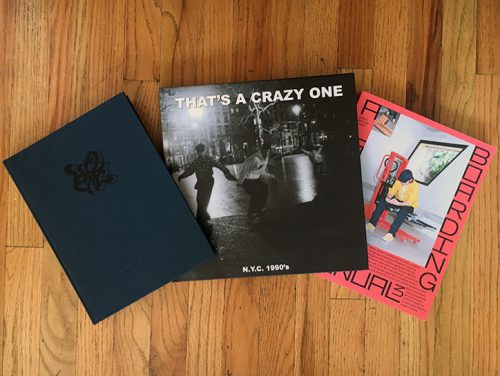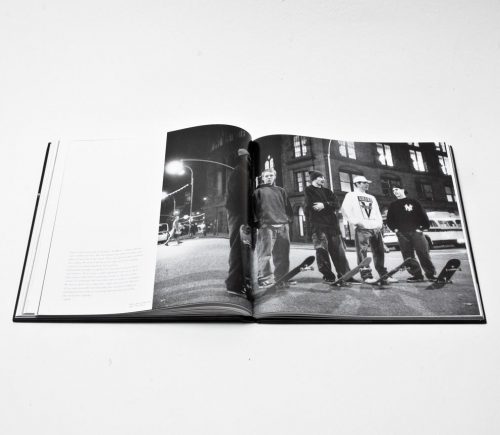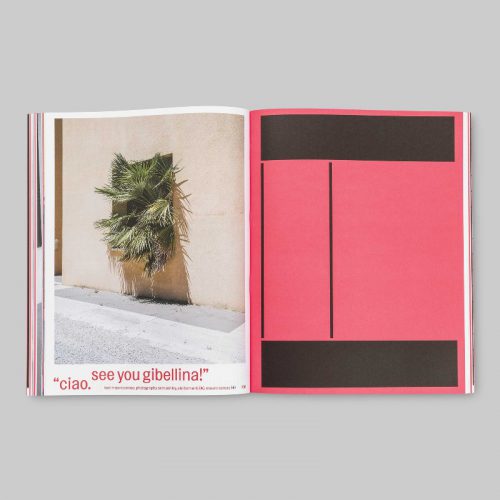*Asterisk because two out of three of these blurbs are for photo books, with one of them (the first one) having probably less than a thousand words overall. Anyway, all three of these came out over the course of the past few months, and all of them deserve your time, especially as August grinds the skateboard news cycle to a near halt. Shout out to everyone putting cool shit on pieces of paper and sharing it with the rest of the world, whether it’s a ‘zine, a book or whatever the hell else ♥
Love — Paradigm Publishing
Love is less a book of skate photos, and more a visual essay of what skateboarding looks like when it’s forced to become a form of protest.
Jonathan Rentschler’s book tells the story of Love Park’s final years — a period most visibly represented by Brian Panebianco’s Sabotage series — in black and white photographs. Love was the first time I felt genuine anger while looking through a book about skateboarding: anger at the cops raising up skateboards in smiley triumph as they confiscate them, anger at police officers pulling people by the hair after they throw them to the ground, anger at the politicians attending a groundbreaking ceremony for the park’s destruction, who will no doubt spend as little time in its remodeled incarnation as they did when they were leading a stubborn crusade against the thing giving it life. These images are interjected with a portrait of the community that corralled in a place they were told was not for them. This is not limited to the skaters, but also fringes of society who those same faces of civil service often prefer to ignore.
At this current moment in American history, it is hard not to put a political spin on every little thing. Decisions are made based on knee-jerk promises of “law and order,” with little conversation behind what that even entails, and whose lives will be affected by these veiled power grabs. Love — the place and the book — is about public space in its rawest form. It underlies what the struggle to be seen and heard means in the greater American story.
Flipping through the book, I thought about the fate of the original Penn Station, which was a majestic building that architects lobbied for the preservation of in the 1960s, until it was torn down and converted into the hunk of shit you may know today. Though a small group of romantics may not have saved that one building, it did establish future precedent for when New York tried to pull the same stunt on Grand Central a decade later. Skateboarders, DC shoes, Rob Dyrdek, the X-Games, Ed Bacon himself, the millions of dollars funneled into Philadelphia’s economy by skaters, and genuine common sense may not have saved Love Park, but let its tragedy be a lesson next time a city falls face first into something so irreplaceable.
[Buy Love here]
That’s A Crazy One [Self-Published]
Everyone’s version of their own youth is the best youth. The photos and words of High and Mel Stone’s That’s A Crazy One lament the days before New York entered a “coma,” a time when things were less predictable, and the effects of the Giuliani administration had yet to set the city on the course it has been on for two-plus decades. With that being said, contributors to our own book chronicling the adolescence of the extended family behind QS (roughly 10-12 years after the photos in this book were taken) also pined for a time before the city became “childproof.” Yet we didn’t grow up at a time when things were as free as they were for High, Mel and their friends. We grew up with cell phones in a Starbucks-ified world that our elders detest.
Even though something like QS is vicariously engrossed in the culture of the years that preceded it, would any of us change anything? Obviously no. Are kids eight, nine, ten years younger than us going to be nostalgic for some bygone era experienced today when they’re ten, twenty years older? Obviously yes.
Everyone’s affinity for the notion of youth runs parallel to experience. The difference between you and me, and the faces on the pages of That’s A Crazy One is that outsiders initially took their story and repackaged it. Every piece of publicity surrounding the book has mentioned Kids, and That’s A Crazy One is eager to present the people depicted in that film as actual people. It is “a portrait of what so many had tried to capture from the outside,” an account of friends “beyond anything they saw on a screen,” where negativity is left to “the pervert Larry, and the Hollywood shit.”
High and Mel’s photos are candid and universal, even if the setting they were taken in, which they celebrate so dearly, no longer exists. Though none of us like to admit it, the setting of our youths is often superficial — a shortcode to tell a story with visual cues. The feelings people get from those they love and those who love them at the most carefree point in their lives are at the core of That’s A Crazy One, and something only those who felt them firsthand are qualified to present to the rest of us. I’m grateful they showed us the true story.
[Buy That’s A Crazy One here]
A Skateboarding Annual 3 — Carhartt Work in Progress
As much as we may miss those beautiful issues of Norway’s [presumably] defunct Dank mag, over the past three years, Carhartt WIP has been producing the best skateboard magazine for grown ups.
A Skateboarding Annual has come out each of the past three summers to compile a year’s worth of special projects by the brand. The issues look and feel like fancy fashion magazines you’d pick up for $25 at a Soho newstand, and sometimes you’ll go several pages without seeing a single image of a skateboard. The current issue showcases heady skate-theory guy, Raphaël Zarka’s, work with found forms, Donald Judd-inspired minimalist sculpture and crystallography. It illustrates (as in, there are no photographs…) a trip to a tea factory in the mountains of Munnar, India. It follows Mauro Caruso’s quest to film a part in the Sicilian ghost city of Gibellina, while annotating the article with footnotes about the Italian sculptors and architects whose work decorates the background. Much of the coverage leans heavily on WIP’s European core, but what it does feature of Americans revolves around site favorites like Max Palmer, Andrew Wilson and Chris Milic.
If the greatest trick to writing about skateboarding is that you don’t write about skateboarding, Carhartt WIP figured out a solid niche in producing something special for aging skate nerds with peripheral interests in art, design and travel.
[Buy A Skateboarding Annual 3 here]









“If the greatest trick to writing about skateboarding is that you don’t write about skateboarding”….EXACTLY!